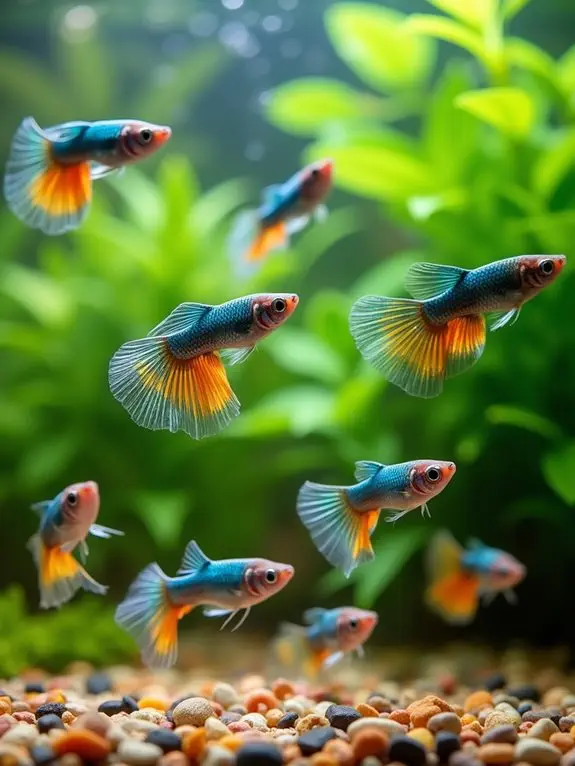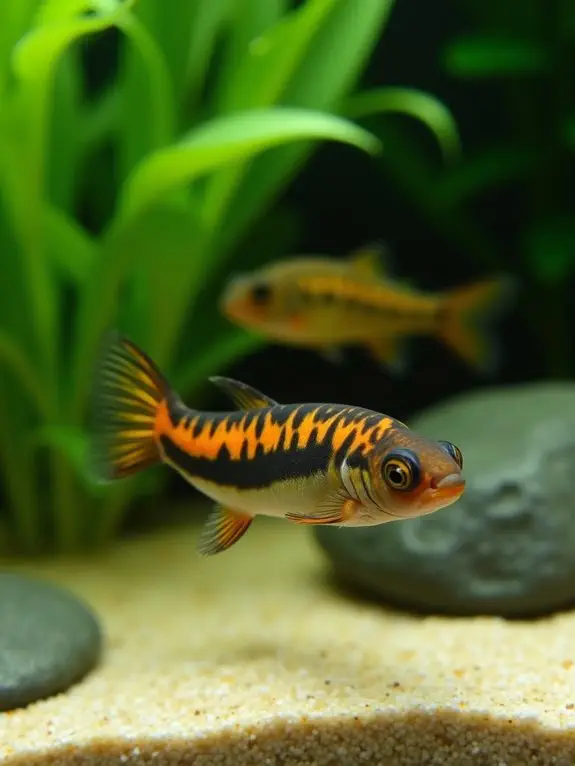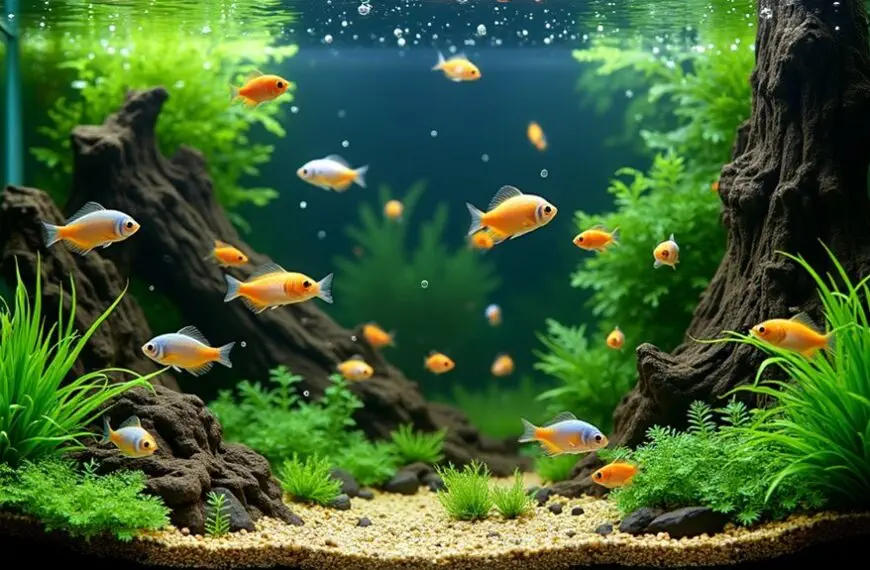Looking for peaceful community tank residents? You’ll love neon tetras, corydoras catfish, platies, cherry barbs, and guppies for their colorful, non-aggressive nature. Add otocinclus catfish and bristlenose plecos for algae control, while dwarf gouramis and kuhli loaches contribute unique behaviors. Harlequin rasboras round out your top ten with their striking appearance and schooling habits. These compatible species create a harmonious underwater world with minimal drama and maximum visual appeal.
Contents
- 1 Neon Tetras: Colorful Schooling Companions
- 2 Corydoras Catfish: Peaceful Bottom Dwellers
- 3 Platies: Hardy and Vibrant Community Fish
- 4 Cherry Barbs: Gentle Mid-Level Swimmers
- 5 Guppies: Low-Maintenance Showstoppers
- 6 Harlequin Rasboras: Harmonious Shoaling Species
- 7 Otocinclus Catfish: Algae-Eating Tank Cleaners
- 8 Dwarf Gouramis: Serene Labyrinth Fish
- 9 Kuhli Loaches: Non-Aggressive Nocturnal Beauties
- 10 Bristlenose Plecos: Docile Algae Control Experts
- 11 Frequently Asked Questions
- 11.1 Can Peaceful Fish Species Be Kept With Live Aquarium Plants?
- 11.2 How Many Peaceful Fish Can I Safely Add per Gallon?
- 11.3 Do Peaceful Community Fish Need Specific Water Parameters to Thrive?
- 11.4 Which Community Fish Are Best for Nano Tanks Under 10 Gallons?
- 11.5 Can These Peaceful Species Be Kept With Freshwater Shrimp or Snails?
- 12 Final Thoughts
Neon Tetras: Colorful Schooling Companions
Flashes of electric blue and vibrant red make neon tetras one of the most popular choices for community tanks. These tiny jewels, barely reaching an inch long, will bring your aquarium to life with their peaceful, schooling behavior.
For proper neon tetra care, you’ll want to keep at least six together, as they thrive when swimming in groups and may become stressed when alone.
When selecting neon tetra tankmates, you’ve got plenty of options! They get along wonderfully with other non-aggressive species like guppies, corydoras catfish, and peaceful dwarf gouramis. Neon tetras are especially suited for small tank environments where they can flourish among their companions without stress.
You’ll love watching them dart through plants and explore the middle water column of your tank. Just avoid housing them with large, predatory fish that might see these little beauties as a quick snack!
Corydoras Catfish: Peaceful Bottom Dwellers
Corydoras catfish, with their whiskered faces and armored bodies, bring both charm and function to the bottom of your community tank. These peaceful scavengers work tirelessly to keep your aquarium clean by sifting through substrate for leftover food and debris.
When setting up your tank for corydoras, provide a soft, sandy bottom that protects their sensitive barbels as they engage in their natural sifting behavior. You’ll love watching them dart to the surface for quick gulps of air—a unique characteristic of these lovable bottom dwellers!
Keep corydoras in groups of six or more, as their social behavior makes them happiest when they’re with friends. They’ll reward you with playful antics, like synchronized swimming and the occasional “wink” with their movable eyes, making them irresistible additions to any peaceful community. Additionally, ensuring a proper tank size of 10 gallons is essential for their well-being and comfort in a community aquarium.
Platies: Hardy and Vibrant Community Fish

Platies will bring a splash of color to your tank with their vibrant red, blue, and yellow patterns that stand out against greenery.
You’ll find these hardy swimmers perfect for your first aquarium, as they’re incredibly forgiving of minor water quality fluctuations.
They’re naturally peaceful fish that get along with nearly all tankmates, making them ideal citizens in any community aquarium setting. Additionally, they thrive best when maintained in groups of at least six, promoting their social interactions and overall well-being.
Colorful Peaceful Swimmers
Among the most sought-after community tank inhabitants, hardy and vibrant platies bring a splash of color to any aquarium.
You’ll love watching these active little fish dart through your tank, showing off their orange, red, blue, or yellow patterns. They thrive in colorful habitats with plenty of plants and open swimming spaces, making them perfect for well-decorated community setups.
Platies are known for their peaceful interactions with other species, rarely causing trouble even in crowded tanks.
They’re sociable creatures that prefer living in small groups, where you’ll notice their playful behavior and curious nature.
The best part? They’re incredibly easy to care for! Even if you’re new to the hobby, these resilient fish forgive minor water quality fluctuations and adapt well to various conditions. Additionally, regular monitoring of water quality parameters is the key to maintaining a healthy environment for your platies.
Their cheerful presence will brighten your aquarium for years to come.
Easy Beginner Fish
While colorful fish bring visual excitement to your tank, let’s now focus on species that won’t cause you stress as you begin your aquarium journey.
Platies are perfect companions for your first fish tank setup, bringing both hardiness and vibrant colors to your underwater community.
You’ll love how these little swimmers adapt to various water conditions, making beginner fish care much simpler. They’re peaceful by nature and won’t nip at other tank residents.
With their striking orange, red, and yellow patterns, platies add personality without demanding complicated care routines.
Feed them quality flakes twice daily, guarantee your filter works properly, and they’ll thrive for years. Their active swimming and curious personalities will quickly make them your favorite residents as you build confidence in maintaining your aquatic community. Additionally, they thrive best in groups of 3-6 together, which promotes social behavior and happiness among the fish.
Cherry Barbs: Gentle Mid-Level Swimmers
Cherry Barbs offer the perfect blend of vibrant color and peaceful temperament for community tanks.
A splash of scarlet serenity, Cherry Barbs brighten any aquarium while maintaining peaceful community dynamics.
You’ll love watching these elegant mid-level swimmers dart through your aquarium, adding splashes of red against green plants. When breeding cherry barbs, you’ll notice males develop more intense crimson coloration to attract females. Their cherry barb behavior is consistently non-aggressive, making them ideal tankmates for other peaceful species.
- Thrive in groups of 5+ fish, where they’ll display their most natural and interesting social behaviors
- Adapt well to various water conditions, making them suitable for beginners
- Live 5-7 years with proper care, providing long-term enjoyment
Additionally, they are resilient fish that can handle minor care mistakes, making them suitable even for novice aquarists. You won’t regret adding these charming fish to your community aquarium—they’re the perfect balance of eye-catching beauty and easygoing personality that won’t disturb your aquatic harmony.
Guppies: Low-Maintenance Showstoppers

Guppies bring a dazzling array of colors to your aquarium while requiring minimal effort in return.
These tiny fish, often called “million fish” due to their prolific breeding habits, will quickly populate your tank if males and females are kept together. You’ll be amazed at how breeding guppies can produce offspring with unique color patterns in each generation.
The variety of guppy colors available today is truly spectacular—from vibrant blues and fiery reds to metallic greens and mosaic patterns.
Males sport elaborate, flowing tails that they proudly display during courtship. They’re peaceful by nature and get along with most non-aggressive tank mates.
With their ability to thrive in various water conditions and their striking appearance, it’s no wonder guppies remain a favorite choice for beginners and experienced aquarists alike. Additionally, proper water quality monitoring is crucial for maintaining a healthy environment for these colorful fish.
Harlequin Rasboras: Harmonious Shoaling Species
When you’re looking for ideal tank companions, Harlequin Rasboras won’t disappoint with their peaceful nature and striking orange-and-black triangle patterns.
These vibrant fish will bring your aquarium to life as they gracefully swim in tight-knit groups, creating a mesmerizing display that’s both calming and dynamic.
You’ll notice improved fish health and reduced stress when you keep them in groups of six or more, making them not just beautiful additions but practical ones for maintaining harmony in your community tank. Additionally, maintaining proper water quality parameters is essential for their health and well-being.
Ideal Tank Companions
Many aquarists consider Harlequin Rasboras (Trigonostigma heteromorpha) to be perfect community tank residents due to their peaceful nature and striking appearance.
When planning your fish compatibility, you’ll want to pair these orange-copper beauties with species that share their gentle temperament and tank environment preferences.
- Tetras, especially Neon and Ember varieties, make excellent companions as they occupy similar water levels and share peaceful dispositions.
- Corydoras catfish create a perfect bottom-dwelling complement, cleaning up food while staying out of the Rasboras’ mid-water territory.
- Small peaceful gouramis like Honey or Dwarf Gouramis add color variety while maintaining tank harmony.
You’ll be amazed at how Harlequin Rasboras bring your community tank to life without causing drama—they’re like the friendly neighbors everyone wants! Additionally, these fish thrive in groups of six, enhancing their natural behavior and increasing their colorfulness in the tank.
Vibrant Orange Patterns
The striking appearance of Harlequin Rasboras doesn’t just make them excellent tank companions—it’s also what attracts many aquarists to this species in the first place.
You’ll be mesmerized by their triangular black patch set against their copper-orange bodies, creating one of the most distinctive aquatic patterns in the freshwater hobby.
When kept in groups of six or more, their vibrant colors really pop as they swim together in graceful formation. Their upper bodies shimmer with an orange-gold hue that catches the light beautifully, especially when they dart across well-planted tanks.
Unlike some flashy fish that fade in captivity, Harlequins maintain their brilliant coloration when properly fed and housed. You’ll find their consistent, flame-like appearance brings a warm, cohesive aesthetic to community tanks that few other species can match. Additionally, they thrive in peaceful community settings, making them an ideal choice for beginner aquarists.
Schooling Behavior Benefits
Watching Harlequin Rasboras swim together reveals why these fish are considered schooling superstars in the aquarium hobby.
You’ll notice their synchronized movements create a beautiful display of orange flashes darting through your tank. These natural schoolers thrive in groups of six or more, showcasing fascinating social dynamics that benefit both the fish and your aquarium ecosystem.
The schooling advantages of Harlequin Rasboras include:
- Reduced stress levels for each fish, leading to healthier, more vibrant specimens
- Enhanced visual appeal as they move in coordinated patterns throughout your tank
- Natural behavior that helps prevent aggression and promotes overall tank harmony
You’ll find that their tight schooling behavior not only creates a mesmerizing display but also signals that your aquarium environment is stable and healthy—a win-win for both you and your finned friends!
Otocinclus Catfish: Algae-Eating Tank Cleaners
Algae-eaters with a gentle disposition, Otocinclus catfish serve as nature’s janitors in your community aquarium. These tiny workers, rarely exceeding two inches, diligently scrape away unwanted algae without disturbing other tank inhabitants.
Their peaceful Otocinclus behavior makes them ideal roommates even for shy species, as they’ll never chase or nip at neighbors.
You’ll love watching their algae management skills in action as they methodically clean glass, plants, and decorations. Unlike larger plecos, these little cleaners won’t outgrow your tank or damage delicate plants.
They prefer company, so keep them in groups of at least three. Just remember, they’re not miracle workers – they can’t handle severe algae blooms on their own!
Provide supplemental food when algae is scarce to keep these hardworking custodians healthy and happy.
Dwarf Gouramis: Serene Labyrinth Fish

Your dwarf gouramis will add a splash of personality to your community tank with their vibrant colors and peaceful demeanor, making them compatible with most non-aggressive tank mates.
You’ll notice these labyrinth fish have a unique breathing adaptation that allows them to gulp air from the surface, giving them their distinctive behavior patterns.
Male gouramis showcase their natural instincts by crafting intricate bubble nests at the water’s surface, a fascinating breeding behavior you can observe even if you’re not planning to breed them.
Colorful Personality Traits
Dwarf Gouramis bring a tranquil energy to community tanks while showcasing some of the most vibrant colors in the freshwater world.
Their colorful personality is evident in how they gracefully navigate the tank, often displaying unique behaviors that’ll captivate your attention. You’ll notice they’re curious but shy, occasionally investigating new additions to their habitat before retreating to familiar territory.
- They use their specialized labyrinth organ to gulp air at the surface, a fascinating behavior you won’t see in many other fish.
- Males build bubble nests when ready to breed, showing off their natural parenting instincts.
- They communicate through subtle color changes, becoming more vibrant when feeling confident or during courtship.
These peaceful creatures balance their striking appearance with gentle temperaments, making them perfect centerpieces in community aquariums.
Tank Mate Compatibility
When selecting companions for your peaceful Dwarf Gouramis, compatibility becomes the cornerstone of a harmonious aquatic community. These gentle labyrinth fish thrive alongside similarly calm species that won’t compete for territory or nip at their flowing fins.
You’ll want to maintain tank size considerations of at least 20 gallons for a small community, giving everyone enough space to establish their own territory. Remember, cramped quarters lead to stressed fish and potential aggression!
Water parameters should remain consistent, with temperatures between 74-82°F and slightly acidic to neutral pH (6.5-7.5). Your Gouramis will appreciate tank mates that enjoy similar conditions, such as tetras, rasboras, and small corydoras catfish.
Avoid faster, fin-nipping species like tiger barbs that might turn your serene community into an underwater chase scene!
Bubble Nest Building
Among the most fascinating behaviors you’ll observe in your aquarium, bubble nest building showcases the natural instincts of male Dwarf Gouramis. These colorful labyrinth fish create elaborate floating homes from saliva-coated bubbles at the water’s surface, preparing for potential breeding.
You’ll notice this bubble nest behavior intensifies when males are ready to attract a mate.
- Males guard their nests fiercely, maintaining and repairing them throughout the breeding process.
- Bubble nests can span up to 3 inches wide, often anchored under floating plants.
- The size and quality of the nest can influence a female’s breeding decision.
This impressive display of breeding strategies provides a window into their natural life cycle.
When your Dwarf Gourami starts building, it’s a sign your aquarium conditions are comfortable and your fish is thriving.
Kuhli Loaches: Non-Aggressive Nocturnal Beauties

Kuhli loaches, with their eel-like bodies and distinctive stripes, bring a touch of exotic beauty to the bottom of any community tank. These peaceful scavengers reach about 3-4 inches in length and prefer to live in groups of at least five or six.
Like elegant ribbons in motion, these striped scavengers transform your aquarium’s bottom into a mesmerizing display of natural beauty.
You’ll find their nocturnal behavior fascinating, as they become more active when the lights go down, slithering through substrate searching for leftover food.
Kuhli loach care is surprisingly straightforward. They thrive in soft, slightly acidic water between 73-86°F. Provide a sandy substrate to protect their sensitive barbels, and include plenty of hiding spots like caves and driftwood.
They’re shy at first, but once comfortable, you’ll catch glimpses of their playful personalities. Their non-aggressive nature makes them perfect tankmates for almost any peaceful community fish.
Bristlenose Plecos: Docile Algae Control Experts
Bristlenose plecos offer an entirely different set of benefits than their bottom-dwelling counterparts.
These armored catfish are the unsung heroes of tank maintenance, quietly grazing on algae while you’re fast asleep. You’ll love how these docile creatures keep your aquarium walls sparkling clean without disturbing other fish. Breeding bristlenose plecos is surprisingly straightforward compared to many other species, making them perfect for hobbyists looking to expand their aquatic family.
- Stays small (4-6 inches) unlike common plecos that can grow enormous
- Lives peacefully with almost any community fish, even small tetras and guppies
- Requires minimal care beyond some driftwood for rasping and hiding
Their distinctive bristly noses give them character, and you’ll find yourself smiling as they suction onto glass, displaying their unique personality.
Frequently Asked Questions
Can Peaceful Fish Species Be Kept With Live Aquarium Plants?
Yes, peaceful fish species are compatible with live aquarium plants. You’ll want to research fish compatibility to guarantee your chosen species won’t damage or uproot your plants. Most peaceful fish and plants make excellent tank companions.
How Many Peaceful Fish Can I Safely Add per Gallon?
You can follow the “one inch of fish per gallon” rule for fish stocking, but it’s oversimplified. Consider your aquarium size, filtration quality, and each species’ needs for healthier, more comfortable fish.
Do Peaceful Community Fish Need Specific Water Parameters to Thrive?
Yes, community fish need specific water parameters. You’ll need to maintain proper water quality and guarantee appropriate temperature range for your chosen species. Each fish has unique requirements that you should research before purchasing.
Which Community Fish Are Best for Nano Tanks Under 10 Gallons?
For nano tank compatibility, you’ll want to contemplate chili rasboras, ember tetras, or celestial pearl danios. These ideal fish species thrive in smaller spaces and won’t outgrow your tank under 10 gallons.
Can These Peaceful Species Be Kept With Freshwater Shrimp or Snails?
You’ll find many peaceful fish compatibility options with freshwater shrimp and snails. Nano species like rasboras, tetras, and guppies generally make excellent shrimp tank mates, as long as you don’t choose larger varieties that might prey on them.
Final Thoughts
You’ve now discovered ten fantastic fish that’ll bring peace and beauty to your community tank. Whether you’re drawn to the flashy neon tetras or the hardworking bottom dwellers, these species will coexist harmoniously in your aquatic world. Remember, a successful aquarium isn’t just about beautiful fish—it’s about creating a balanced ecosystem where everyone gets along. Your new underwater community awaits, and these peaceful swimmers are ready to make it home!












